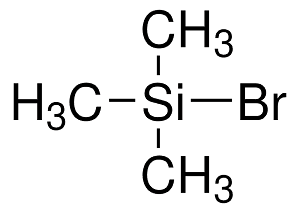Trimethylbromosilane

Product Description
Trimethylbromosilane is an organosilicon compound with the chemical formula (CH3)3SiBr. It finds various industrial applications owing to its unique properties.
Product:
Trimethylbromosilane
CAS:
2857-97-8
Synonym:
Bromotrimethylsilane; Trimethylsilyl bromide
Structure:

Typical Characteristics
Appearance
Colorless to light yellow liquid
Boiling point
79 °C
Density
1.16 g/cm3
Flash Point
32 °C
Melting point
-43 °C
Molecular Weight
153.09
Odor
Pungent odor
Purity
97%
Refractive index
1.424
Uses, Applications & Markets
Key applications
get a quote
We Offer Trimethylbromosilane
in various grades
A few of the grades available are listed below:



Trimethylbromosilane used in many
industry applications
Trimethylbromosilane is an organosilicon compound with the chemical formula (CH3)3SiBr. It finds various industrial applications owing to its unique properties. Here's a list of some of its industrial uses:
- Silicone Polymers: Trimethylbromosilane is commonly used as a precursor in the synthesis of silicone polymers. It reacts with silanol groups (-Si-OH) to form silicone oligomers and polymers, which are widely employed in sealants, adhesives, lubricants, and coatings due to their heat resistance, flexibility, and chemical inertness.
- Surface Modification: Trimethylbromosilane can be applied for surface modification of various substrates, including glass, ceramics, and metals. It forms a thin, hydrophobic layer on the surface, imparting water repellency, anti-sticking properties, and chemical resistance.
- Chemical Synthesis: Trimethylbromosilane serves as a versatile building block in organic synthesis reactions, particularly in the production of functionalized silanes, siloxanes, and silicones. It participates in cross-coupling reactions, hydrosilylation reactions, and nucleophilic substitution reactions.
- Catalysis: Trimethylbromosilane can act as a Lewis acid catalyst in various organic transformations, such as Friedel-Crafts acylation, cyclization reactions, and polymerization reactions. It promotes the formation of carbon-carbon and carbon-heteroatom bonds in synthetic processes.
- Electronics: Trimethylbromosilane-based materials are utilized in the electronics industry for applications such as semiconductor manufacturing, dielectric layers, and surface passivation. They provide insulation, moisture resistance, and dielectric properties in electronic devices and integrated circuits.
- Pharmaceuticals: Trimethylbromosilane derivatives may have pharmaceutical applications as intermediates in the synthesis of pharmaceutical compounds or as reagents in drug discovery processes. They can be used in the production of specialty chemicals and pharmaceutical ingredients.
- Organometallic Chemistry: Trimethylbromosilane is employed in organometallic chemistry as a source of trimethylsilyl (-Si(CH3)3) groups. It reacts with various metal compounds to form organosilicon-metal complexes, which can serve as catalysts or precursors in organic synthesis and materials science.
- Hydrophobic Coatings: Trimethylbromosilane-based formulations are used to create hydrophobic coatings on surfaces such as textiles, paper, and plastics. These coatings repel water and other liquids, preventing moisture ingress and enhancing durability.
- Adhesion Promoters: Trimethylbromosilane can function as an adhesion promoter or coupling agent in composite materials and adhesive formulations. It improves the bonding between dissimilar materials and enhances the adhesion strength of adhesives and sealants.
- Oil and Gas Industry: Trimethylbromosilane may find applications in the oil and gas industry for gas purification, corrosion protection, and drilling fluid additives. It can be used to modify the properties of drilling fluids and enhance the performance of downhole equipment.